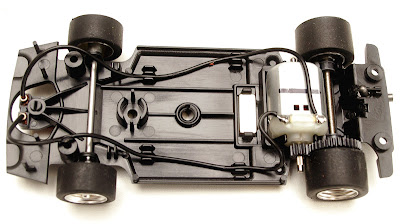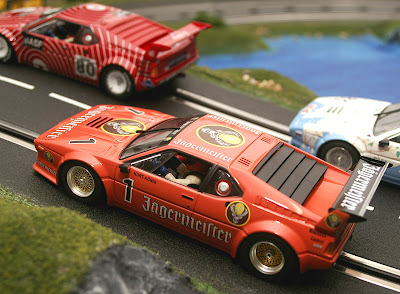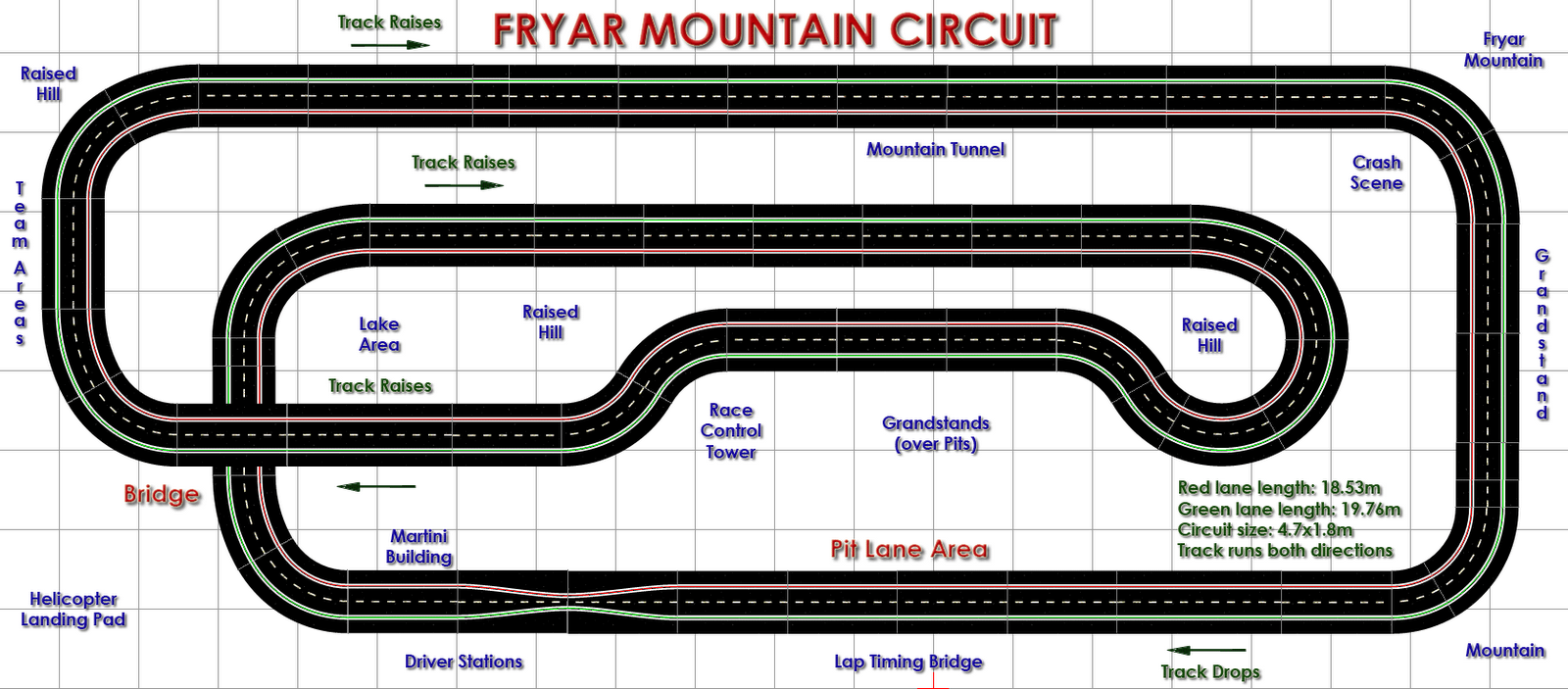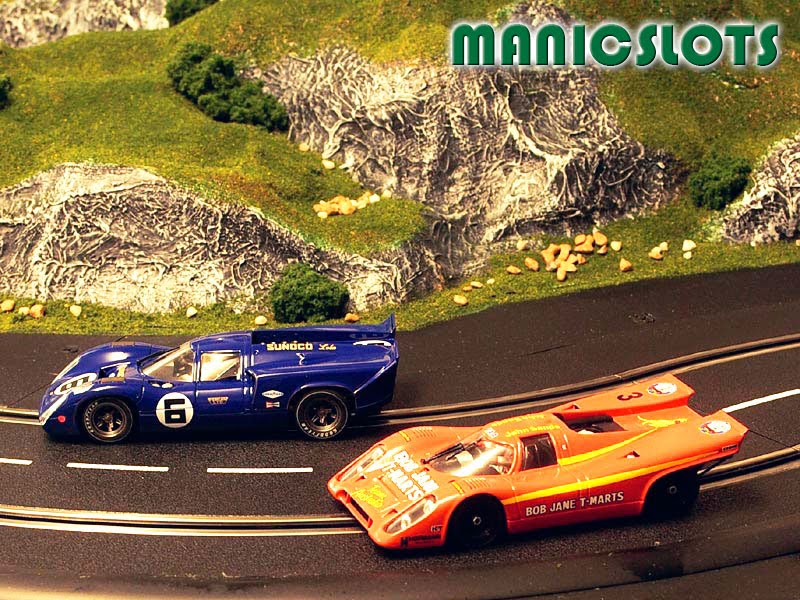
────────────────────────────────
Eat, Sleep, Slot Car, Repeat...News, Reviews, Views and How-To's on everything slot car and scenery related!







────────────────────────────────


HISTORY
The number 1 Jägermeister DRT BMW M1 was raced by Kurt Konig in 1982. Yep, that's it! I would have liked to have found out more history about this car but was unable. If any readers have some information about this car please feel free to comment.
PRESENTATION
The Jägermeister BMW M1 comes in Fly's standard crystal presentation box with the usual Fly blue card reminding us that this slot is not suitable for children under 14 years old. Something I have enjoyed showing my wife from time to time. :)
The paint finish of this car is excellent and the orange paint looks deep and glossy. There is no sign of any paint runs and the decals are very crisp and clean. Unfortunately Fly continue to apply decals post their clear coat process, fortunately their decals can take a fair amount of bash and crash. If you look at the 'Jägermeister' lettering it looks more like 'Jägermeifter'. This is because the font type is an old german style where 's' look a little like 'f'. (Thanks to Volker for this info).
 QUALITY & DETAIL
QUALITY & DETAILProbably the most striking aspect to this release, (except for the Jägermeister livery) would be the gold wheels. The wheels really complement the Jägermeister orange very well. I had trouble validating Fly's wheel choice on this slot as original photos of the car are hard to find. I have several Fly BMW M1s and these wheels are by far the most impressive, particularly the deep silver rimmed rears.
The front of the M1 is pretty basic but accurately reflects the 1:1 race car. There is a black plastic grill, tow hook and clear lights. Side indicators, door handles, locks and bonnet clasps are hand painted which is a nice detail touch. The side rear vision mirrors are made of plastic and although they have a little play look like they would not survive a hard impact.
One thing I did notice with the front of the car is that there is no Jägermeister decal on the passenger side front bumper, (you can see it's clearly missing from the photo 2 up). The 1:1 historic photo in this review shows white text on the bumper in this location so I'd say Fly missed this one.

The rear of the M1 looks great, huge rear wheels, rear window cover and rear wing give the car an aggressive appearance. The rear lights, gear box and exhaust detail complete the scene. The rear tail is glued in place but does have a small degree of movement and looks like it would stand up to countless hard knocks. There is limited under side chassis detail although I'm of the opinion that some detail under the chassis does add to the model even if you can't see it when the slot is running.

As you can see in the above photo, the M1 comes with huge rear rubber that is quite soft and grip well especially by Fly standards. I'm not aware if MJK or any other after market tire manufacture makes rubber for the BMW M1. Even if they do, I don't think this car would greatly benefit as it handles corners very well and little acceleration is lost due to lack of grip.
As you can see from the above and below photos, the M1 chassis is a tried and tested formula; a side-winder motor mount with a large bar magnet. The chassis reminds me of the Scalextric DTM chassis that are so good on plastic track. Similar to Scalextric cars, there is a location for a button magnet towards the front of the chassis. I'm happy to say that this car doesn't need anymore magnetic down-force. If you wanted to, you could add a little weight up front although my car had no deslotting issues during testing. This hole can also be used if wish to convert this car to digital.
The body comes easily away from the chassis via 4 screws, you will need to slip it out forwards due to the exhaust. The front axle is solid metal which is a relief as so many Fly cars come with stub plastic axles. There is however a fair degree of vertical travel in the front wheels and I can see how this may cause rubbing of the front guards. If your front wheels are rubbing on the body work of the car, this can cause a breaking effect that impedes the performance of the slot. My track has a high degree of vertical variation but I didn't experience any issues with the front wheels.
 There is a massive amount of lateral movement in the rear axle, probably 2-3mm. This is a very common issue with Fly slot cars and the number one reason for their general 'from-the-box' average performance. Fortunately there is an easy fix and you won't need a doctorate in slot car medicine to administer it. What you need to do is eliminate the lateral movement in the rear axle. By installing a small shim (or washer) on the rear axle you will be able to eliminate this problem and transform your M1 into a beast.
There is a massive amount of lateral movement in the rear axle, probably 2-3mm. This is a very common issue with Fly slot cars and the number one reason for their general 'from-the-box' average performance. Fortunately there is an easy fix and you won't need a doctorate in slot car medicine to administer it. What you need to do is eliminate the lateral movement in the rear axle. By installing a small shim (or washer) on the rear axle you will be able to eliminate this problem and transform your M1 into a beast.
Remove the chassis from the body and then remove one of the rear wheels, (typically the non-gear side wheel is easier) and insert the shim on the axle, then replace the wheel, (make sure the wheel is tight). Reassemble the slot and check the clearance to the rear guards, you don't want wheel rubbing on the body. I used two thin shims as the 'play' in the rear axle was large and I wanted to keep the body offset of each rear wheel the same for appearances. Be careful not to over shim as this can cause the rear wheels to rub on the rear guards.
Interior detail is good with roll cage, separate 5 point driver's harness, dash and steering wheel detail, rear view mirror and driver decals.

PERFORMANCE
As previously discussed, you will need to modify the rear axle a little to get this slot really flying, pun intended. Once the rear end has been shimmed you will need to true the rear rubber. The rear rubber is not badly out of true but one of my rear tires had a mold lip on the outer edge. This would prevent the tire from rolling a little through the corners and also prevent 100 percent contact with the track. Once I had trued my tires the M1 really started to sing.
 I previously compared the M1's chassis with that of a Scalextric DTM side-winder chassis. This is in chassis configuration only, the M1 is a very different car to drive than a Scalextric DTM. For one it's not stuck to the road and if pushed will slide coming out of corners. Although the M1 is only powered by an 18K standard Fly motor acceleration and braking is very good. Fly have chosen a 36 tooth spur and 11 tooth pinion gear which is the same configuration for all BMW M1s. It's a good gear ratio and accounts for the crisp acceleration and good breaking.
I previously compared the M1's chassis with that of a Scalextric DTM side-winder chassis. This is in chassis configuration only, the M1 is a very different car to drive than a Scalextric DTM. For one it's not stuck to the road and if pushed will slide coming out of corners. Although the M1 is only powered by an 18K standard Fly motor acceleration and braking is very good. Fly have chosen a 36 tooth spur and 11 tooth pinion gear which is the same configuration for all BMW M1s. It's a good gear ratio and accounts for the crisp acceleration and good breaking. Flys release of the BMW M1 was a master stroke as it is a very popular 1:1 race car. Releasing the BMW M1 in the popular Jägermeister livery was a stroke of genius. This car comes with a few small issues which I like to think of as 'Fly character'. Once these small issues are addressed, this car becomes a great looking, driver's slot car and you can't ask for more than that. Whether you race or shelf this car, you won't be disappointed for one second.
Flys release of the BMW M1 was a master stroke as it is a very popular 1:1 race car. Releasing the BMW M1 in the popular Jägermeister livery was a stroke of genius. This car comes with a few small issues which I like to think of as 'Fly character'. Once these small issues are addressed, this car becomes a great looking, driver's slot car and you can't ask for more than that. Whether you race or shelf this car, you won't be disappointed for one second.
The Fly Jägermeister BMW M1 goes straight into 'Manic's collectible slotcars' list.
Overall Manic Score: 5.4 Gears

────────────────────────────────
 DOWN UNDER PROXY RACE 2008
DOWN UNDER PROXY RACE 2008For those of you new to the concept of slot car proxy racing, it's basically entering a car into a series of races on various different tracks typically in different cities and sometimes even in different countries. This means that slot car enthusiasts from all over the world can compete in common events even though they may have never met. If you haven't entered a proxy before, I can honestly tell you it's a lot of fun and a great way to find out more about our hobby and meet like minded people.
Your entry must be built to a specified set of regulations that govern aspects such as type of car, body, chassis and running gear, (motor, gears, tires, wheels, etc). Cars are then raced by round hosts, (typically the track owner and a few friends) and points awarded accordingly to overall round finishing position. Points are carried throughout the entire series, (usually 6-12 rounds) and the final standings determined at the end of the series. Round results and photos are posted on the web after each round so you can follow your entries progress.

The 2008 Down Under Proxy Race, (DUPR) will be organised by members of the Auslot Forums. Last year's DUPR was held over 10 rounds between April and September in Australia. This years proxy will be a similar format but a different category of motor car. The photo below shows last year's impressive line-up of Classic Sports Racing Cars 1960 to 1971. This year the proxy category will be Sports Sedans manufactured prior to 1990. You can find out more about this category of motor car here; http://www.sportssedan.com.au/about.php
 There is an entry fee of $AU12.00 for Australian entries and $AU17 for overseas entries, (all fees include the cost of return postage). To find out more, head over to Auslot Forums where you can read about the proxy and become a member if you like. The best thing about Auslot Forums is it's free and run by guys who love slot cars!
There is an entry fee of $AU12.00 for Australian entries and $AU17 for overseas entries, (all fees include the cost of return postage). To find out more, head over to Auslot Forums where you can read about the proxy and become a member if you like. The best thing about Auslot Forums is it's free and run by guys who love slot cars!
Everything you need to know about the DUPR 2008 can be found on the Auslot Forums here;
http://www.auslot.com/forums/index.php?showforum=53

────────────────────────────────










────────────────────────────────
Posted by Manic at 18:07 13 comments
Labels: Car , How-To , Scenery , Slot Cars , Woodland Scenics



